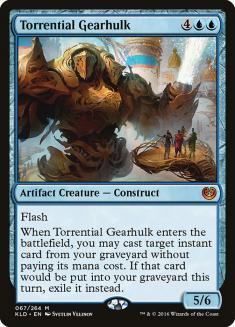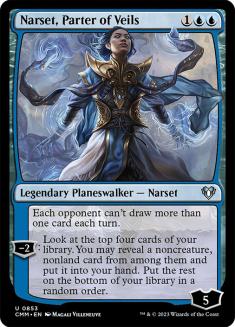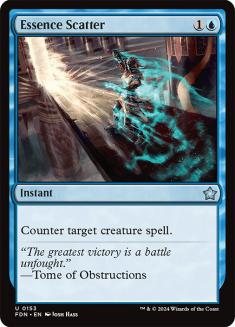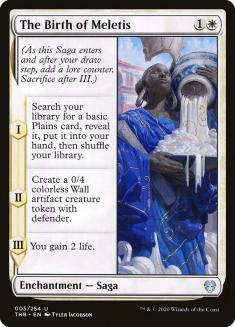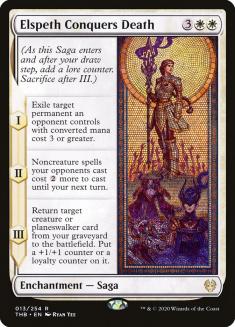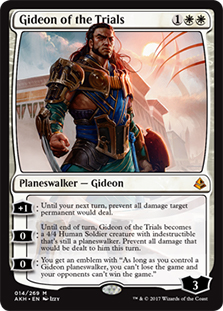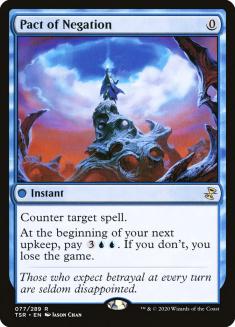I was cautiously optimistic about the return of Torrential Gearhulk to competitive Magic. Wanting something to be good does not make it so, especially when looking at a six-mana creature in Historic. The deck is stacked against expensive win conditions in this format while Sacrifice variants, Goblins, and a host of other aggressive decks are still holding strong. Even with the assistance of control staples being introduced through Kaladesh Remastered, the format remains one of the most aggressive out there. Torrential Gearhulk is one of the best value cards control has seen in a decade, but it requires time to prepare its arrival.
The best trait of Torrential Gearhulk is its size. Snapcaster Mage will always be the better card, producing a much cheaper and stronger effect; however, Torrential Gearhulk can smush an incoming attacker with ease. The 5/6 body on this creature provides both defensive and offensive capabilities, making it a viable win condition in any control deck. I have never leaned on Snapcaster Mage to deal my opponent lethal damage, whereas Torrential Gearhulk crashes in for twenty before you know it. In Historic, this strength holds true, since the removal is weak, and the enemy creatures are typically much smaller.
The addition of Torrential Gearhulk did not send my win percentage through the roof but did make matchups easier across the board. The impact of this flash creature makes combat manageable as it gives us additional copies of counterspells and card draw. The range of this spell is what makes it dynamic and the cause for the increased productivity of Azorius Control. Games are won decisively, without having to depend on Teferi, Hero of Dominaria to solve all your problems. The lack of instant-speed removal has been an issue for Azorius Control in Historic, which Torrential Gearhulk helps solve. Even though Settle the Wreckage is not Path to Exile, it can be scarier when the threat of a Torrential Gearhulk exists.
I had to make changes to accommodate the new win condition. I added cards like Disallow, Glimmer of Genius, and another Settle the Wreckage to put Torrential Gearhulk at full strength. This is the list I wrote about earlier this month.
Creatures (2)
Planeswalkers (9)
Lands (23)
Spells (26)

This list predates the new format going live. I was pleasantly surprised on how well it performed when put to the test, since many of these card choices were theoretical in nature. With the fastest decks out there just waiting to pounce on a slow control deck, I had to make sure it did not lose its core mission. Gideon of the Trials with Pact of Negation, supported by a ton of sweepers, is what makes Azorius Control strong in Historic. I kept that shell intact and worked around the late-game to get the Torrential Gearhulk team involved.
Gameplay was great, matches were close, but some cards felt way off to me. The new cards were overperforming; however, I found issues with a few of the stock choices that have been in all Azorius Control lists. Narset, Parter of Veils is the first culprit and I recognized that one earlier.
In some initial lists that were having success, they all decided to run four copies of Narset, Parter of Veils. This goes back to what I want to be good, compared to what is good in the format. Narset is not the all-star we want it to be against aggressive decks. It is rarely a dud, since it gets a decent spell from the top four cards prior to getting gunned down, but that isn’t good enough for Historic. I dropped it down to two copies in the maindeck, which still turned out to be too many. The early turns are all about survival and Narset often falls short in that department.
Conditional spells that do not work with Torrential Gearhulk, or that require a bunch of mana in the mid-game to be effective, had to go as well. Syncopate is another universally accepted staple in Azorius Control. The draw to a counterspell like this is its versatility. Turn 2 should never go unused in a Historic control deck. If The Birth of Meletis is not the play, then some form of disruption must come down against the aggro decks of the format.
Syncopate played a powerful role in this mission, stopping a Turn 2 threat, or something a bit later for a little more mana. The mana investment in the late-game has turned out to be too big of a price to justify a weaker spell like this, especially with Rest in Peace in the sideboard.
Rest in Peace makes Azorius Control viable on its own, shutting down graveyard strategies with ease. Most conventional Azorius Control decks in Historic were using a few copies of Grafdigger’s Cage and one copy of Rest in Peace. After playing with both extensively, Rest in Peace is leaps and bounds the stronger hate piece. I started with one copy of Grafdigger’s Cage in the list you see above, but quickly reverted to using Rest in Peace to combat the Sacrifice (and other graveyard) decks. Since I have Rest in Peace, cards like Syncopate lose most additional value in the sideboarded games. That, combined with its lack of Torrential Gearhulk synergy, is the reason why I moved to different blue disruption spells in this updated list.
Creatures (2)
Planeswalkers (7)
Lands (23)
Spells (28)

Essence Scatter was the easy replacement for Syncopate. In a format dominated by creatures, it is an obvious change that Azorius Control had to make. It is strong in the early-, mid-, and late-game, with the option of getting reused by Torrential Gearhulk on Turn 6.
The advantages to Essence Scatter go beyond that. There are very few decks that would dare to play zero creatures in Historic, making Essence Scatter rarely a dead card. The fear of no targets is what has made it less playable over the years, but I will be using it with confidence against the metagame in its current form.
To add to the anti-aggro theme, I also added a third copy of The Birth of Meletis. This card continues to impress me in the older formats, doing everything I wish Wall of Omens could have done in the past. Getting a land, a blocker, and two life is the best deal control in Historic can get for a two-mana investment.
Since Azorius Control is fully dependent on Wrath of God, The Birth of Meletis is often stronger than a simple removal spell. This is not a dig on Baffling End, but an acknowledgement on the power level of creatures in the format. Killing one Goblin on Turn 2, on the draw, is not going to cut it in Historic. Providing that vital fourth land, some damage absorption over a few turns with a blocker, and a couple of life points back is all the help Wrath of God needs to clean up the mess.
A few other small changes made Azorius Control battle-ready for the new Kaladesh Remastered format. The reduction of Narset, Parter of Veils from the original version was not enough, as we discussed. I took the last two copies out of the maindeck to make room for the third The Birth of Meletis and a single Shark Typhoon. Shark Typhoon is rarely a dud, since it has cycling, and it adds to the flash dynamic of this new Azorius Control deck.
All these changes have increased the consistency of hitting land drops and disrupting the early-game of aggressive decks, while not significantly reducing the chances of defeating one of the grindy decks of the format.
I made the manabase a bit cleaner and the sideboard more streamlined to defeat the top decks. Field of Ruin has been painful to draw in the early-game. This has always been the case with colorless lands; however, they were necessary to defeat some of the big-mana decks of their respective formats. In Historic, those lands are not around to torment control players.
There are still problematic nonbasic lands that produce an annoying level of advantage, but a couple of copies of Field of Ruin won’t cut it. The utility lands will not make or break you, like an Urza’s Tower would, but would require the same amount of Fields to stop them. Running one or two copies will result in color issues more frequently than shutting down a Castle Vantress, so I decided to strengthen the manabase instead.
The sideboard has some serious changes from the traditional Azorius Control decks. One thing that we can all agree on is that Aether Gust is a staple three- or four-of moving forward. Red and green decks have all asserted their dominance over Historic, especially with the freeing of Burning-Tree Emissary. I do not think Gruul Aggro is any more broken than Mono-Red Goblins, but it has the explosiveness that makes control pay for having weak answers.
The removal that Azorius Control has in Historic is embarrassing, to put it lightly, except in the sweeper column. With Wrath of God and Settle the Wreckage being so strong, we need just a little survival assistance in the early-game. Aether Gust does this the best, due to its versatility against multiple decks and the synergy it has with Torrential Gearhulk.
I did not want to dunk on Narset too hard in this article but I cannot help the aggressive metagame it tries to operate in. There are always ramp, control, combo, and midrange decks lurking around, making Narset a staple in sideboarded games. It, combined with Elspeth Conquers Death, gives Azorius Control that same powerful lane of attack that it had in Standard for a few months. It feels just as good in Historic landing an Elspeth Conquers Death, especially with Torrential Gearhulk or Teferi, Hero of Dominaria as targets.
The card I miss the most from this list is Mystical Dispute. The lack of blue-based decks in Historic makes me emotional; however, I understand why. Aggro has received all the Research and Development team’s love in the last few years, making it a bit risky to play an archetype like this.
Most of the maindeck and sideboard are dedicated to defeating creatures and that seems to be the formula for success. It is possible that soon, when people acknowledge the power of Teferi, Hero of Dominaria again, Mystical Dispute will be back in business. Dovin’s Veto and Disdainful Stroke are left holding down the fort when some additional blue disruption is needed against the few brave souls like us out there.
Recently my BCW teammate and buddy Corey Baumeister picked my list up and ran with it for a few events. He loved the feeling of a Gideon of the Trials emblem into a Pact of Negation, something that everyone should experience a few times in their Magic life. He believed the deck was very strong and used it with success on his stream, as well as through playtesting on Arena. I recently asked him if he made any changes and he downgraded his opinion of the deck significantly, mentioning he was playing just about the same list I originally posted.
That is the beauty of Magic — a deck that feels wonderful for a few days, but then turns completely south as the metagame shifts. The small additions I made here, to address the constant aggressive uptick Historic is going through, have made all the difference in the world. I was having similar struggles that Corey had against the same decks, requiring me to abandon some of my pet cards in order to meet the metagame’s demands. Our control decks must continue to evolve in order to remain competitive in Historic.


